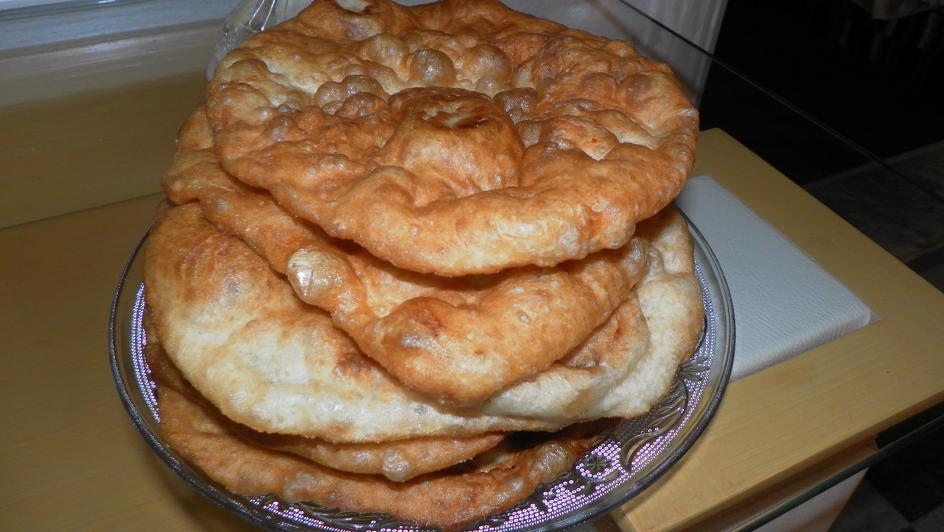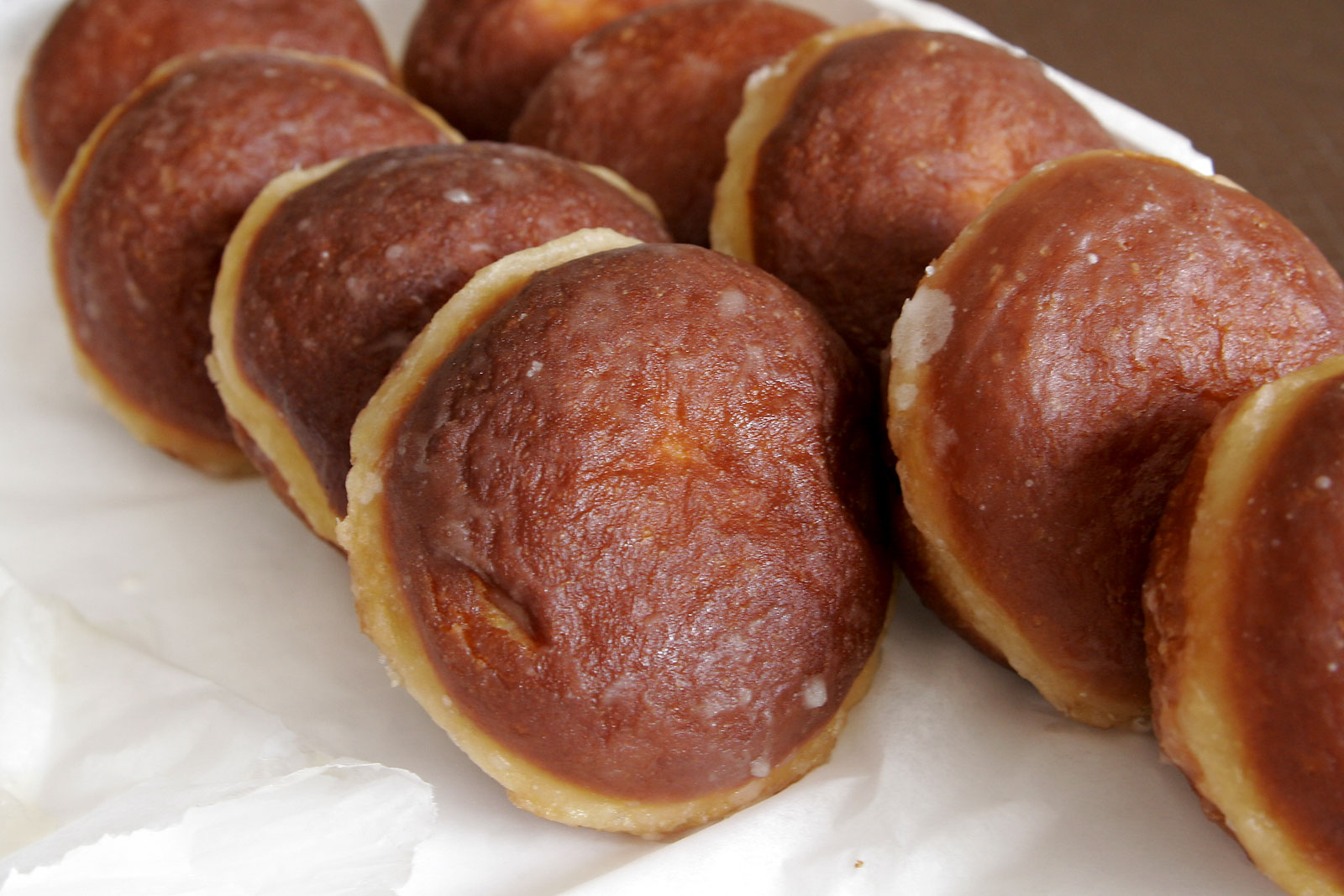|
Bambalouni
Bambaloni, also referred to as bambalouni, is a sweet Tunisian donut. It can be made at home or bought from fast food shops. It is prepared with a flour dough fried in oil. The bambaloni is eaten sprinkled with sugar or soaked in honey. It can be eaten at any time of day. It inspired the Sfenj donut that is widely consumed throughout the Maghreb, which is also known as sfinz in Libya. Gallery Bambaloni 2.jpg Balbalounii.jpg Bambalouni 07.JPG See also *Bombolone, the Italian version of the Bambalouni *Sfenj *Sfinz *List of doughnut varieties *List of fried dough varieties *Cuisine of Tunisia *Tulumba *Fritelli *Puff-puff *Cuisine of Libya The cuisine of Libya is Arab and Mediterranean with Italian influence. One of the most popular Libyan dishes is ''bazin'', an unleavened bread prepared with barley, water and salt. ''Bazin'' is prepared by boiling barley flour in water and then b ... * Cuisine's that originate in Libya References External links * {{Cuisine of T ... [...More Info...] [...Related Items...] OR: [Wikipedia] [Google] [Baidu] |
Sfenj
Sfenj (from the Arabic word ar, السفنج, Safanj, meaning sponge) is a Maghrebi doughnut: a light, spongy ring of dough fried in oil. Sfenj is eaten plain, sprinkled with sugar, or soaked in honey. It is a well-known dish in the Maghreb and is traditionally made and sold early in the morning for breakfast or in the late afternoon accompanied by tea—usually Maghrebi mint tea—or coffee. The term sfenj is used in Algeria and other parts of the Maghreb. It is called ''bambalouni'' in Tunisia, and ''sfinz'' in Libya. In Morocco, the term "sfenj" is used, also sometimes nicknamed in the literature "Moroccan doughnuts". It is also called ''Khfaf'' or ''ftayr'' in Algeria, and is sometimes also dubbed as the "Algerian doughnut". Outside the Maghreb, sfenj is often eaten by Moroccan Jews and other Sephardim in Israel and elsewhere for Hanukkah. Sfenj and other doughnuts are eaten for Hanukkah because they are fried in oil, commemorating the Hanukkah miracle wherein the oil that ... [...More Info...] [...Related Items...] OR: [Wikipedia] [Google] [Baidu] |
Sfinz
Sfenj (from the Arabic word ar, السفنج, Safanj, meaning sponge) is a Maghrebi doughnut: a light, spongy ring of dough fried in oil. Sfenj is eaten plain, sprinkled with sugar, or soaked in honey. It is a well-known dish in the Maghreb and is traditionally made and sold early in the morning for breakfast or in the late afternoon accompanied by tea—usually Maghrebi mint tea—or coffee. The term sfenj is used in Algeria and other parts of the Maghreb. It is called ''bambalouni'' in Tunisia, and ''sfinz'' in Libya. In Morocco, the term "sfenj" is used, also sometimes nicknamed in the literature "Moroccan doughnuts". It is also called ''Khfaf'' or ''ftayr'' in Algeria, and is sometimes also dubbed as the "Algerian doughnut". Outside the Maghreb, sfenj is often eaten by Moroccan Jews and other Sephardim in Israel and elsewhere for Hanukkah. Sfenj and other doughnuts are eaten for Hanukkah because they are fried in oil, commemorating the Hanukkah miracle wherein the oil that ... [...More Info...] [...Related Items...] OR: [Wikipedia] [Google] [Baidu] |
Sfinz
Sfenj (from the Arabic word ar, السفنج, Safanj, meaning sponge) is a Maghrebi doughnut: a light, spongy ring of dough fried in oil. Sfenj is eaten plain, sprinkled with sugar, or soaked in honey. It is a well-known dish in the Maghreb and is traditionally made and sold early in the morning for breakfast or in the late afternoon accompanied by tea—usually Maghrebi mint tea—or coffee. The term sfenj is used in Algeria and other parts of the Maghreb. It is called ''bambalouni'' in Tunisia, and ''sfinz'' in Libya. In Morocco, the term "sfenj" is used, also sometimes nicknamed in the literature "Moroccan doughnuts". It is also called ''Khfaf'' or ''ftayr'' in Algeria, and is sometimes also dubbed as the "Algerian doughnut". Outside the Maghreb, sfenj is often eaten by Moroccan Jews and other Sephardim in Israel and elsewhere for Hanukkah. Sfenj and other doughnuts are eaten for Hanukkah because they are fried in oil, commemorating the Hanukkah miracle wherein the oil that ... [...More Info...] [...Related Items...] OR: [Wikipedia] [Google] [Baidu] |
Cuisine Of Tunisia
Tunisian cuisine, the cuisine of Tunisia, consists of the cooking traditions, ingredients, recipes and techniques developed in Tunisia since antiquity. It is mainly a blend of Mediterranean and native Punics-Berber cuisine. Historically, Tunisian cuisine witnessed influence and exchanges with many cultures and nations like Italians, Andalusians, French and Arabs. Like many countries in the Mediterranean basin, the Tunisian cuisine is heavily based on olive oil, spices, tomatoes, seafood and meat. Yet, it has a distinctive spiciness that differs it from surrounding cuisines. Origins Tunisian cuisine developed from Berbers, ancient Carthage, Rome, the Islamic conquest of the Maghreb, and the Ottoman Empire. The cuisine has been strongly influenced by French and Italian (especially Sicilian) cooking. During its era of French colonial rule Tunisia marketed its difference to metropolitan France meaning it played on French perceptions of "difference" ( Orientalism) to sell th ... [...More Info...] [...Related Items...] OR: [Wikipedia] [Google] [Baidu] |
Fritelli
Fritelli (singular ''Fritellu''), also Fritelle (singular ''Fritella'') are Corsican doughnuts or fritters made from fried wheat Schapira (1994) p. 123 or chestnut flour (Fritelle castagnine).Silvani (1991) p. 113 A preparation of the fritters is referred to as Fritelli di Casgiu Frescu with fresh cheese (or Brocciu)Silvani (1991) p. 161 or Fritelli di Salciccia with sausage. According to an 1880 ''Scribners monthly'' account, the chestnuts were collected from those that had fallen (and beating the trees to knock them down was discouraged). The nuts were then taken to huts and placed six-inches deep in trays where they were slow cooked with green wood fires until hard and dry. In this state they could be kept for years and were milled into flour "like corn or wheat", which was then made into fritelli or other dishes such as "pulenta" (polenta), necci, pattoni, castagnacciu, and cialdi. See also *List of fried dough *List of doughnut varieties *Bambalouni * References Sources ... [...More Info...] [...Related Items...] OR: [Wikipedia] [Google] [Baidu] |
Bombolone
A bombolone (, pl. bomboloni) is an Italian filled doughnut (similar to the Berliner, krafne, pączek etc.) and is eaten as a snack food and dessert. The pastry's name is etymologically related to ''bomba'' (bomb), and the same type of pastry is also called bomba (''pl.'' "bombe") in some regions of Italy. The etymological connection is probably due to the resemblance to a grenade or old-fashioned bomb and may today possibly also be regarded as a reference to the high calorie density of this recipe (i.e., a "calorie bomb"). History While ''bomboloni'' may be primarily connected to Tuscany, they are traditional to other regions of Italy, although with slight variations on the recipe. In those areas that used to be under Austrian rule, such as Trentino Alto-Adige, Veneto and Friuli-Venezia Giulia, the tradition of bomboloni is believed to have originated from that of Austrian "krapfen" (i.e., Berliner), and the recipe includes eggs, which are not found in the Tuscan variety. ... [...More Info...] [...Related Items...] OR: [Wikipedia] [Google] [Baidu] |
Tunisian Cuisine
Tunisian cuisine, the cuisine of Tunisia, consists of the cooking traditions, ingredients, recipes and techniques developed in Tunisia since antiquity. It is mainly a blend of Mediterranean and native Punics-Berber cuisine. Historically, Tunisian cuisine witnessed influence and exchanges with many cultures and nations like Italians, Andalusians, French and Arabs. Like many countries in the Mediterranean basin, the Tunisian cuisine is heavily based on olive oil, spices, tomatoes, seafood and meat. Yet, it has a distinctive spiciness that differs it from surrounding cuisines. Origins Tunisian cuisine developed from Berbers, ancient Carthage, Rome, the Islamic conquest of the Maghreb, and the Ottoman Empire. The cuisine has been strongly influenced by French and Italian (especially Sicilian) cooking. During its era of French colonial rule Tunisia marketed its difference to metropolitan France meaning it played on French perceptions of "difference" (Orientalism) to sell the p ... [...More Info...] [...Related Items...] OR: [Wikipedia] [Google] [Baidu] |
List Of Doughnut Varieties
Doughnuts are a type of fried dough food. The following is a list of doughnut varieties. Variations and specialties by region The terms below constitute either names for different doughnut types created using local recipes, or for the local language translation of the term for an imported doughnut product. * Argentina – Kreppel, also called ''tortas fritas'' (fried pastries), is a fried pastry or quick bread that was introduced by German immigrants, and is similar to the Berliner. Facturas are a popular baked doughnut found in every corner bakery. Other names that may be seen in bakeries are ''berlinesas'' and ''bolas de fraile'' ("friar's balls"). * Armenia – ''Ponchik'', borrowed from Russian, is a deep-fried piece of dough shaped into a flattened sphere and filled with confiture or other sweet filling. ''Tukalik'' are similar to doughnut holes, and Armenian doughnuts are referred to as ''chickies''. * Australia – Kitchener bun, Similar to Berliner, but with an open ... [...More Info...] [...Related Items...] OR: [Wikipedia] [Google] [Baidu] |
List Of Fried Dough Varieties
This is a list of fried dough foods. Many cultures have dishes that are prepared by deep frying dough in many various forms. Doughnuts are a type of fried dough food that are covered separately in the Wikipedia article List of doughnut varieties. Fried dough foods }, ur, جلیبی, pa, ਜਲੇਬੀ, te, జిలేబి) or Jilapi ( bn, জিলাপী), this is a deep-fried sweet batter with rose water and saffron. Similar to Persian Zoolbiya. , - , Jersey wonders , , Jersey , These are also known as ''Mèrvelles'' , - , Jin deui , , China , A hollow fried pastry made of glutinous rice flour that is coated with sesame seeds and filled with a sweet filling. , - , Johnny Cake , , US Virgin Islands , Unleavened, golden-sweet, semi-flattened,fluffy-fried bread made primarily of white flour. , - , Kabkab , , Philippines , Deep-fried cassava wafers , - , Kachori , , India , Dough balls filled with different kinds of savoury stuffings like de-skinne ... [...More Info...] [...Related Items...] OR: [Wikipedia] [Google] [Baidu] |
Arab Cuisine
Arab cuisine ( ar, المطبخ العربي) is the cuisine of the Arabs, defined as the various regional cuisines spanning the Arab world, from the Maghreb to the Fertile Crescent and the Arabian Peninsula. These cuisines are centuries old and reflect the culture of trading in baharat (spices), herbs, and foods. The regions have many similarities, but also unique traditions. They have also been influenced by climate, cultivation, and mutual commerce. Medieval cuisine Breads The white bread was made with high-quality wheat flour, similar to bread but thicker, the fermented dough was leavened usually with yeast and "baker's borax" () and baked in a '' tandoor''. One poetic verse describing this bread: "In the farthest end of Karkh of Baghdad, a baker I saw offering bread, splendidly marvelous. From purest essence of wheat contrived. Radiant and absolute, you may see your image reflected, crystal clear. rounds glowing with lovely whiteness, more playful than gorgeous singin ... [...More Info...] [...Related Items...] OR: [Wikipedia] [Google] [Baidu] |
Cuisine Of Libya
The cuisine of Libya is Arab and Mediterranean with Italian influence. One of the most popular Libyan dishes is ''bazin'', an unleavened bread prepared with barley, water and salt. ''Bazin'' is prepared by boiling barley flour in water and then beating it to create a dough using a ''magraf'', which is a unique stick designed for this purpose. Pork consumption is forbidden, in accordance with Sharia, the religious laws of Islam."Libya." Accessed June 2011. |




